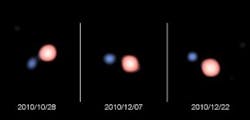ESO's telescope interferometer images two stars orbiting each other
| Imaged by ESO's Very Large Telescope Interferometer (VLTI), the SS Leporis system consists of a red-giant star orbiting a hotter companion. Note: the stars have been artificially tinted to match their known temperatures. (Credit: ESO/PIONIER/IPAG) |
Cerro Paranal, Chile--Astronomers working with the European Southern Observatory's (ESO's) Very Large Telescope Interferometer (VLTI) have captured nicely resolved images of a binary star system 1080 light years away.1 The images of the SS Leporis system show two stars--a red giant and a massive blue star-- separated by only a little more than the distance between the Sun and the Earth. The blue star has consumed about half the mass of the larger red star, which has a diameter about the size of the orbit of Mercury. The two stars circle around each other in 260 days.
The VLTI, which was tested using light from all four of the large 8-m-aperture unit telescopes of ESO's Very Large Telescope on 17 March 2011, can attain a resolution of about one milliarcsecond -- about 50 times better than the Hubble Space Telescope.
To image the binary stars, light was fed from four smaller 1.8-m auxiliary telescopes into a new instrument called PIONIER. Developed at LAOG/IPAG (Grenoble, France), PIONIER is a visiting instrument at the Paranal Observatory. Once the light reached PIONIER, it was then channeled into a optical circuit that combined the four inputs. The resulting resolving power of the telescope array has the sharpness of a "virtual telescope" about 130 meters across, limited only by how far apart the telescopes can be positioned.
"We can now combine light from four VLT telescopes and create super-sharp images much more quickly than before," says Nicolas Blind of IPAG, the lead author of the paper presenting the results. "The images are so sharp that we can not only watch the stars orbiting around each other, but also measure the size of the larger of the two stars."
"We knew that this double star was unusual, and that material was flowing from one star to the other," says co-author Henri Boffin, from ESO. "What we found, however, is that the way in which the mass transfer most likely took place is completely different from previous models of the process. The 'bite' of the vampire star is very gentle but highly effective."
REFERENCE:
1. N. Blind et al., Astronomy & Astrophysics, in press.
